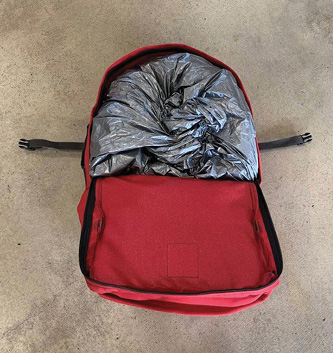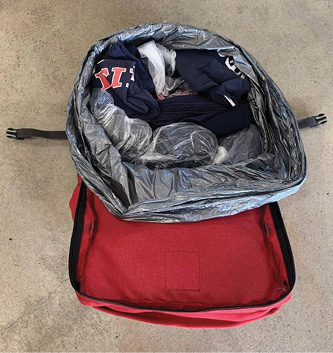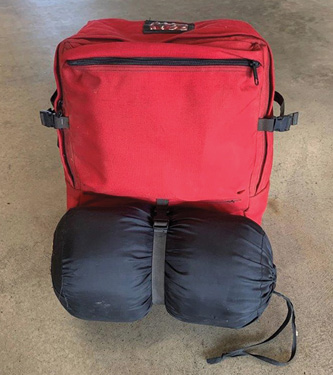
Wildland Urban Interface ❘ By BRYAN McLEAN
In some parts of the country, one facet of being in the fire service is the readiness to respond to larger wildland campaign fires. Depending on the fire department, personnel may be deployed from seven to 21 days, with a typical deployment of 14. This requires personnel to be packed and ready to go when the call for resources comes in.
The “Red Bag”
Other than your personal protective equipment (PPE), the next most important item to have is the infamous “red bag.” Essentially, this is a go bag that each firefighter has packed and ready to go during the ever-expanding fire season months. The red bag gets its name from the old red bags made by FSS for packing your clothing, toiletries, and other items for longer deployments. Over the years, other manufacturers have built on the original bag, but several people still refer to them as red bags or “out-of-county bags.” The exact list of what to pack may vary depending on your assignment (engine, overhead, and so on). However, the bag should be ready to go at a moment’s notice.


(1, 2) Keeping your clothing enclosed in plastic bags helps protect them from dust and moisture. (Photos by author.)
At first, people tend to pack as much as they can into these bags. Over time, you will fine-tune what you actually use or may need.
Following is a basic inventory and starting point for a 14-day deployment. Exact inventories will differ based on the person, department, and assignment.
The Basics of What to Pack
At a minimum, make sure you pack the following items before every deployment:
-
- Prescription medications.
- A qualification card (sometimes referred to as a “Red Card”).
- Socks—five pairs of quality wool (or similar) socks.
- Undergarments—10 pairs.
- T-shirts—10 pairs.
- Pants—three pairs, depending on single or dual-layer PPE.
- Shorts—two pairs.
- Flip-flops or similar footwear for showers.
- A shower towel that is easy to dry out.
- Toiletry kit, with the following “basics”:
—Deodorant.
—A toothbrush and toothpaste.
—Razors and shaving cream.
—Itch-relief powder.
—Baby wipes (trust me on this one).
—Soap and shampoo.
—Ibuprofen, allergy medicines, gastrointestinal medicines, and so on.
—Moleskin.
—Toilet paper.
- Comfortable shoes for off-hours and shifts.
- A sweatshirt—yes, there are times when you may be deployed to an area that gets rather cold at night, even in the middle of the summer.
- A badge shirt—we call these Class B shirts. We wear them in fire camp and when in public on an off-shift.
- A sleeping bag and pad.
- A laundry bag for dirty laundry.
- Garbage bags.
- A phone-charging cable and battery.
- Cash for emergencies.
- Extra PPE, if you have it.
Some Extra Items to Pack
In addition to the essentials, it would be beneficial to pack the following if packed and ready to use:
- A tent.
- A cot.
- A camping pillow.
- A jet boil with spare fuel and coffee.
- Bug spray.
- Sunblock.
- Spare batteries.
- Rain jacket (depending on the area and time of year).
- A beanie.
Keep It Dry, Get It Cleaned
Newer bags resist moisture and are even waterproof. Another thing to keep in mind is dirt and dust. Depending on where you store these bags on your apparatus, things can get very dusty. So, one method to keep everything clean and dry is to place them in large, zip-lock style bags or even large trash bags. No one wants to get off the line and put on dirty or damp clothing.


(3, 4) The original FSS-style red bag.
Most fire camps have some sort of laundry service. It may be in camp with a portable laundry and contractors, or there may be a laundry in a nearby town. Although this is not always the case, most of the time there is access to some sort of laundry services. The above inventory takes this into account.
Company Officer or Overhead Extras
If you are the company officer or are assigned in an overhead position, you will want to bring some extra items. I usually take a small nylon bag with various forms, pens, flagging, radio plans, and so on. Your exact inventory will depend on your assignment. However, the goal is still the same: to arrive and be ready to go to work.
This may all seem like a lot at first, but these are the basics. However, as your experience evolves, you will find things that others have brought that may make life easier. Or, you may find that you don’t need as much because your assignments and deployments are shorter. Just make sure you have enough quality socks to keep your feet in good condition and enough clothing so they aren’t standing on their own by the end of a few days.
BRYAN McLEAN is a 24-year fire service veteran and a captain with the Cosumnes (CA) Fire Department, where he has worked for the past 13 years including six as captain and two with the training division. McLean has also worked for Novato (CA) Fire Protection District as well as the California Department of Forestry and Fire Protection. He has a bachelor of science degree in fire administration and an associate of science degree in fire science.
Structural Triage in the Wildland Urban Interface

